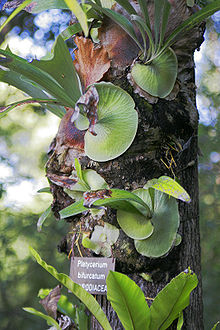bio.wikisort.org - Plant
Platycerium is a genus of about 18 fern species in the polypod family, Polypodiaceae. Ferns in this genus are widely known as staghorn or elkhorn ferns due to their uniquely shaped fronds. This genus is epiphytic and is native to tropical and temperate areas of South America, Africa, Southeast Asia, Australia, and New Guinea.[1]
| Platycerium | |
|---|---|
 | |
| Platycerium bifurcatum from the Australian National Botanical Gardens, Canberra | |
| Scientific classification | |
| Kingdom: | Plantae |
| Clade: | Tracheophytes |
| Division: | Polypodiophyta |
| Class: | Polypodiopsida |
| Order: | Polypodiales |
| Suborder: | Polypodiineae |
| Family: | Polypodiaceae |
| Subfamily: | Platycerioideae |
| Genus: | Platycerium Desv. |
| Species | |
| |
Description
Platycerium sporophytes (adult plants) have tufted roots, growing from a short rhizome, and bear two types of fronds - basal and fertile fronds. Basal fronds are sterile, shield- or kidney-shaped, and laminate against the tree, to protect the fern's roots from damage and desiccation. In some Platycerium species, the top margin of these fronds will grow into an open crown of lobes; catching rainwater, falling forest litter, bird/animal droppings, and even the occasional fallen baby bird or deceased animal, these plants build up their own “compost” system of nutrition over many years.
Fertile fronds bear spores on their undersurface, are dichotomous or antler-shaped, and jut out or hang from the rhizome. The spores are born in sporangia, clustered in large sori that are usually positioned on the lobes, or at the sinus between frond lobes.
Some species of Platycerium are solitary, having only one rhizome. Other species form colonies when their rhizomes branch, or when new rhizomes are formed from root tips. If the conditions are right, the spores will germinate naturally, on surrounding trees. Platycerium gametophytes are a small, heart-shaped thallus.
Platycerium have diverged into four natural groups. Several Platycerium are strongly adapted to xeric conditions, with a naturally drought-tolerant metabolism method having been reported for P. veitchii.[2]
Species
| Image | Name | Distribution |
|---|---|---|
 | Platycerium alcicorne Desv . | Colombia, Mozambique and Madagascar. |
 | Platycerium andinum Baker | Colombia, Bolivia and Peru. |
 | Platycerium angolense Welw. ex Baker (Syn .: Platycerium elephantotis Schweinf.) | Colombia, tropical Africa. |
 | Platycerium bifurcatum (Cav.) C. Chr . | Australia states of New South Wales and Queensland. |
 | Platycerium coronarium (J. Koenig ex O. F. Müll.) Desv . | Indonesia, Malaysia, Singapore, the Philippines, Thailand, Myanmar and Vietnam. |
| Platycerium ellisii Baker | Madagascar only in the provinces of Antsiranana and Toamasina. | |
 | Large antler fern (Platycerium grande (Fée) Kunze) | the Philippines. |
 | Platycerium hillii T. Moore (Also referred to as a variety of Platycerium bifurcatum var. Hillii (T. Moore) Domin) | Queensland and New Guinea. |
 | Platycerium holttumii de Jonch. & Hennipman | Thailand and Indochina. |
 | Platycerium madagascariense Baker | Madagascar in the provinces of Antsiranana, Fianarantsoa and Toamasina. |
| Platycerium quadridichotomum (Bonap.) Tardieu | Madagascar only in Ankarana, Bemaraha, Bemarivo, Montagne d’Ambre including Fôret d'Ambre. | |
 | Platycerium ridleyi Christ | Malaysia, Sumatra and Kalimantan. |
 | Triangle antler fern (Platycerium stemaria (P. Beauv.) Desv.) | tropical Africa. |
 | Magnificent antler fern (Platycerium superbum de Jonch. & Hennipman) | Queensland. |
| Platycerium veitchii (Underw.) C. Chr. (Syn .: Platycerium bifurcatum subsp. Veitchii (Underw.) Hennipman & M. C. Roos) | Queensland. | |
 | Platycerium wallichii Hook . | eastern India, Thailand, Malaysia, Myanmar and western Yunnan. |
 | Platycerium wandae Racib . | Papua New Guinea. |
| Platycerium willinckii T. Moore (Also referred to as a subspecies of Platycerium bifurcatum subsp. Willinckii (T. Moore) Hennipman & M. C. Roos ). | Sulawesi and Java | |
Cultivation
The species Platycerium bifurcatum and Platycerium superbum are commonly cultivated as ornamental plants. These oddly shaped ferns grow on trees and rocks and can be found in gardens, especially tropical gardens.
Staghorns can be propagated by spores produced on the underside of the fertile fronds. Colonial Platycerium can also be vegetatively propagated by carefully dividing large healthy ones into smaller, separate plants. These new plants can then be attached to board mounts or be strapped to trees until they take to the tree themselves.
A mature staghorn can grow more than 1 metre (3.3 ft) wide.
Gallery
- Platycerium superbum at the Royal Botanic Gardens Sydney, Australia
- Platycerium bifurcatum from the Mendut Temple, Indonesia
- Platycerium coronarium from Pahang, Malaysia
- Platycerium grande from Bukidnon, Philippines
- Platycerium elephantotis at Kaisaniemi Botanical Garden, Finland
References
- Hennipman, E. (1982). A monograph of the fern genus Platycerium (Polypodiaceae). Verhandelingen der Koninklijke Nederlandse Akademie van Wetenschappen, Afd. Natuurkunde. Tweede reeks. Amsterdam ; New York: North-Holland. ISBN 0444855696.
- Kreier, Hans-Peter; Schneider, Harald (2006). "Phylogeny and biogeography of the staghorn fern genus Platycerium (Polypodiaceae, Polypodiidae)". American Journal of Botany. 93 (2): 217–225. doi:10.3732/ajb.93.2.217. ISSN 0002-9122. PMID 21646182.
- Holtum, Joseph A.M.; Klaus Winter (1999-01-01). "Degrees of crassulacean acid metabolism in tropical epiphytic and lithophytic ferns". Functional Plant Biology. 26 (8): 749–757. doi:10.1071/PP99001.
На других языках
- [en] Platycerium
[es] Platycerium
Platycerium es un género de helechos de la familia Polypodiaceae, que incluye 18 especies. Los helechos de este género son ampliamente conocidos como helechos cuerno de ciervo o cuerno de alce debido a sus frondas de forma única. Los helechos en este género son muy conocidos por sus características frondas, que recuerdan los cuernos de ciertos ungulados. Es epífito y es nativo de áreas tropicales de Sudamérica, África, Sudeste Asiático, Australia, Nueva Guinea.[ru] Платицериум
Платице́риум, или «Оле́ний рог», или Плоскоро́г[1] (лат. Platycerium) — род папоротников семейства Многоножковые (Polypodiaceae), насчитывает около 17—18 видов, распространённых в тропических лесах Старого Света.Другой контент может иметь иную лицензию. Перед использованием материалов сайта WikiSort.org внимательно изучите правила лицензирования конкретных элементов наполнения сайта.
WikiSort.org - проект по пересортировке и дополнению контента Википедии




